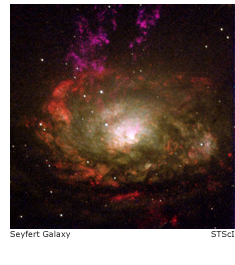|
|
| AST 309R · Galaxies, Quasars, and the Universe |
 1
2
1
2

|
|
Help Sessions
The lecture before each exam will be devoted to reviewing the material on the exam. Additional help sessions will be scheduled
for help with the homework and class material.
Textbook
There is no required textbook. Course content will center on the lectures, supplemented with written materials by the instructor,
materials available on the World Wide Web, and suggested readings.
Drop Dates
 You may drop a course without academic penalty until February 14. You can then drop courses until March 28 with a Q or F,
depending on your performance in class up to that time. March 28 is also the last day to change to or from the credit/no
credit basis. After March 28, you may drop the course or withdraw from the University only for urgent and substantiated,
nonacademic reasons. Please consult the University's published calendar
to verify these dates and for further information.
You may drop a course without academic penalty until February 14. You can then drop courses until March 28 with a Q or F,
depending on your performance in class up to that time. March 28 is also the last day to change to or from the credit/no
credit basis. After March 28, you may drop the course or withdraw from the University only for urgent and substantiated,
nonacademic reasons. Please consult the University's published calendar
to verify these dates and for further information.
Star Parties
Every Wednesday evening, if the weather is clear, there will be astronomical viewing with the 16-inch telescope on the roof of
RLM Hall. These sessions will start about 7 p.m. early in the term and 8 p.m. after daylight saving time takes effect in April.
There is also a 9-inch telescope on Painter Hall that is open to UT students on Friday evenings and to the general public on
Saturday evenings. For observing hours, see the Department of Astronomy public outreach Web page at
http://outreach.as.utexas.edu/public. You can use the 9-inch yourself
if you are checked out on it. McDonald Observatory in west Texas has star parties and public nights (see
http://mcdonaldobservatory.org/visitors/programs;
phone 471-5285).
About the Instructor
Professor Shields was born in Los Angeles, California and grew up in Nebraska and Kansas. He earned a B.S. in Physics from
Stanford University in 1968 and a Ph.D. in Astronomy at Caltech in 1973. Following a postdoctoral fellowship at Harvard,
he joined the UT faculty in 1974. He now holds the title of The Jane and Roland Blumberg Centennial Professor in Astronomy,
and served as Chairman of the Department of Astronomy from 1990 to 1994. He teaches both graduate and undergraduate
courses at UT. His research interests include studies of nebulae, quasars and black holes, and he has published numerous
research papers and popular articles.
Suggested reading:
The Big Bang, by Joseph Silk (2001), W. H. Freeman and Co., 3rd ed. A survey of cosmological ideas
from the ancients to the latest scientific theories. Emphasizes observations and theories of the early universe and galaxy
formation.
Our Evolving Universe, by Malcomb S. Longair (1996), Cambridge Univ. Press. A nonmathematical discussion of the evolution
of the universe, stars, and galaxies. Includes material on quasars and black holes. Emphasizes the interconnection of different
branches of astronomy.
A Short History of the Universe, by Joseph Silk (1994), Scientific American Library (Freeman). A nicely illustrated summary of
modern concepts of the evolution of the universe, ranging from the earliest moments of the Big Bang through the evolution of
galaxies. Many suggestions for further reading.
The Cosmic Perspective, by Jeffrey Bennett et al. (2004, 3rd ed.), Addison Wesley. An introductory
astronomy text; part VI deals with galaxies and the universe. A shorter version called Stars, Galaxies, & Cosmology (2002)
is similar but omits the solar system.
|
|
|
|
|
|

 You may drop a course without academic penalty until February 14. You can then drop courses until March 28 with a Q or F,
depending on your performance in class up to that time. March 28 is also the last day to change to or from the credit/no
credit basis. After March 28, you may drop the course or withdraw from the University only for urgent and substantiated,
nonacademic reasons. Please consult the University's
You may drop a course without academic penalty until February 14. You can then drop courses until March 28 with a Q or F,
depending on your performance in class up to that time. March 28 is also the last day to change to or from the credit/no
credit basis. After March 28, you may drop the course or withdraw from the University only for urgent and substantiated,
nonacademic reasons. Please consult the University's